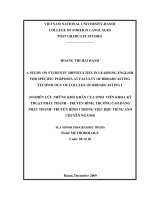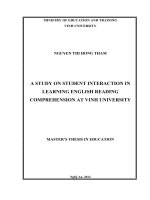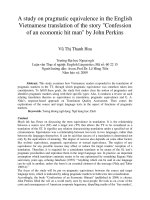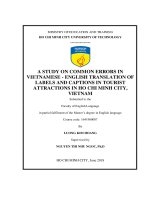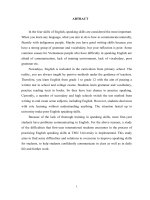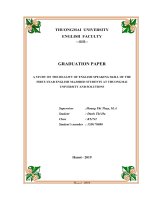A study on student interaction in learning English reading comprehension at Vinh University
Bạn đang xem bản rút gọn của tài liệu. Xem và tải ngay bản đầy đủ của tài liệu tại đây (528.39 KB, 103 trang )
MINISTRY OF EDUCATION AND TRAINING
VINH UNIVERSITY
NGUYEN THI HONG THAM
A STUDY ON STUDENT INTERACTION IN
LEARNING ENGLISH READING
COMPREHENSION AT VINH UNIVERSITY
MASTER’S THESIS IN EDUCATION
Nghệ An, 2014
MINISTRY OF EDUCATION AND TRAINING
VINH UNIVERSITY
NGUYEN THI HONG THAM
A STUDY ON STUDENT INTERACTION IN
LEARNING ENGLISH READING
COMPREHENSION AT VINH UNIVERSITY
Major: Teaching English to Speakers of Other Languages (TESOL)
Code: 60.14.01.11
MASTER’S THESIS IN EDUCATION
Supervisor: Ngo Dinh PhuongAssoc. Prof., Ph.D.
Nghệ An, 2014
STATEMENT OF AUTHORSHIP
I certify my authorship of the M.A thesis submitted today entitled:
A study on student interaction in learning English reading comprehension
at Vinh University
I hereby acknowledge that this study in mine. The data and findings discussed
in the thesis are true and have not been published elsewhere.
Author
NGUYEN THI HONG THAM
i
ACKNOWLEDGEMENTS
Many people have helped me make this thesis possible. First, I would like to
express my profound gratitude to my supervisor, Assoc. Prof Doctor Ngo Dinh
Phuong, who generously supports my work by giving directions, priceless advice
and enthusiastic encouragement during the completion of the study.
I would like to express my special thanks Dr. Tran Ba Tien, the FDL’s Dean,
who gave me the chance and the time to come to the end of this study.
I would also like to express my thanks to the teachers and students at Vinh
University who helped me in providing the materials, answering the survey
questionnaire, taking part in the interviews actively and making constructive
comments in the process of writing this thesis, without their help the thesis would
not have been successful.
Finally, my special appreciation goes out to all the teachers who taught me
during the two year course, my colleagues who are very hearty to give opinions and
suggestions for my research, and to all my friends, my students, and my family who
help me in different ways.
ii
ABSTRACT
This research aims to find out how classroom interaction effects on improving
students’ English reading skill. Firstly, it defines the importance of interaction in
reading classes. Secondly, it seeks to answers what types of interaction patterns
have been used in language classroom at Vinh University. Thirdly, it investigates
how these interaction patterns affect the students’ participation and learning
outcome. The thesis involves 20 teachers and 100 students from two non-English
major classes at Vinh University. The data are collected by questionnaires,
classroom observation, and interview and then statistically analyzed by tables and
charts.
The findings of study show that both teachers and students at Vinh University
think that interaction in class are important and useful. The findings also show that
there are three types of interaction patterns in reading classroom: teacher-student,
student-student and student-content. The data from questionnaire, observation and
interview shows that the teacher-student mode is frequently used in pre-reading
stage and student-student and student-content modes are used more frequently in
while-reading and post reading stage. The teachers applied many appreciate types of
activities and interaction patterns increase students’ interest in reading and
interaction in classes depending on different reading tasks, students’ English levels.
Students can improve their reading skill and language knowledge through these
activities. The effectiveness of classroom interaction described in the test result of
two classes. Finally, the researcher gives some suggestions with the hope that the
students’ English will be improved through promoting classroom interactions by
teachers.
iii
LIST OF TABLES
iv
LIST OF ABBREVIATIONS
CLT: Communicative Language Teaching
ELT: English Language Teaching
EFL: English Foreign Language
ESL: English as Second Language
VU: Vinh University
v
THE LIST OF TABLES
vi
THE LIST OF CHARTS
vii
CHAPTER 1: INTRODUCTION
1.1. Rationales
Nowadays, English is spoken all over the world. People use it as an effective
means of international communication in many fields of life, for example
economics, politics, science, sports, etc. Because of this reason, more and more
people are aware of the importance of English so that they have paid more attention
on learning this international language.
In Vietnam, English has been brought into the school curriculum as a
compulsory subject, and the teaching and learning of that international language has
been recently paid great attention to. When teaching English, the teacher teaches his
students not only the English language but also its usage. And under the right
guidance, right help of the teacher, the students have to try their best to master 4
language skills: reading, writing, listening and speaking in order to communicate in
English successfully. Among these four skills, reading plays an important role in
enriching the students’ general knowledge and in helping them with their further
study later.
Reading comprehension is the ability to understand a written passage of text.
This understanding comes from the interaction between the words that are written
and how they trigger knowledge outside the text/message (wikipedia.org). Reading
comprehension is important because without it reading doesn’t provide the reader
with any information. It allows the readers to interact with the text in a meaningful
way. It helps learners to gain new knowledge and improve many other language
skills such as writing, speaking and listening. For this reason, learners and teachers
of English language should pay more attention on this skill.
However, some interviewed students at Vinh University say that they are not
able to understand what they read and teachers complain that most students do not
like to read, they only read the required text book in order to set for the achievement
routine exams. Students lack of motivation to read, even if they read, they show
negative attitudes. These difficulties in reading may come from many causes. For
example, students lack or poor use of reading strategies, lack of relevant prior
knowledge, lack of reading engagement, etc. Another reason is reading lessons
1
usually take place in quiet classroom, so that I have recognized that interaction in
reading class is really important. Interaction means any communication taken place
in class. Interaction can motivate learning and created the relationship in class.
Classroom interaction is one of the most effective ways to improve students’
reading comprehension. It is where students and teacher exchange their knowledge
and lessons related problems. Through interaction students have more chance to
practice the reading skill. Today, with the popularity of CLT in Viet Nam, English
learners had access to more interactive learning environment. The literature of
English language teaching (ELT) has emphasized the importance of classroom
interactions as the tool for learning motivation.
On the other hand, not many students understand the important of interaction in
their learning and of implementing those strategies efficiently. Therefor I am
motivated to choose the topic “A study on student interaction in learning English
reading comprehension at Vinh University” for my thesis. We hope that the study
will be a contribution to the increase of students’ classroom interaction awareness
and improvement of reading comprehension skills for learners.
1.2. Purpose of the study
The aims of the study are as follows:
- Deeply understanding the perception of interaction in reading class of
students.
- Deeply understand how the student interaction is applied in non-English
major reading classes.
- Applying more activities and reading strategies in interactive reading classes.
- The study is the hope of the author to make some contributions to the
improvement of teaching reading comprehension for non-English majors at Vinh
University.
1.3. Scope of the study
The study focuses on investigating student interaction in non-English major
reading classes. Due to the limitation of time, our study carries out only on student
interaction in classroom and the number of participants in only limited to 20
2
teachers of non-English major and about 100 students from two classes at pre-
intermediate level at Vinh University.
1.4. Research questions
In order to meet the aims of the study, the following research questions are
generated:
- What reading strategies have been used in non-English major classes at Vinh
University?
- How do student interactions effect on reading comprehension in non-English
major classes at Vinh University?
- What suggestions can be made to improve the teaching and learning of the reading
skill via student interactions?
1.5. Research materials
The teaching material currently used for the non- English major students is
the “New Headway Pre-Intermediate the third edition” by Liz and John Soars. This
textbook treats the four skills of listening, speaking, reading and writing thoroughly
and combines traditional methods of language teaching and more recent
communicative ones.
The 12-unit textbook is programmed to be taught in 2 semesters as presented
below in Table 3.1:
Semester
The
number
of credits
Time (50- minute lesson
period/ week)
Units Textbook
1 3 45 lesson periods per 15 weeks 1-5 NewHeadway
Pre-intermediate
the third edition
2 4 60 lesson periods per 15 weeks 6-12
Table 1.1. Distribution of time and units in 2 semesters
3
1.6. The Organization of the study
Chapter 1: Introduction
This part will introduce the issues leading to the study, purpose, scope, and
organization of the study.
Chapter 2: Literature review and theoretical background
Theoretical background relating to the topic and surveys of articles, books
and other resources will be presented. This part will also provide description,
summary, and critical evaluation of each work quoted.
Chapter 3: Methodology
This part presents the detailed procedure of the study: the methodology,
population selection, data collection and analysis.
Chapter 4: Finding and discussion
The part deals with the findings drawn out from the analysis of data. The
findings and discussion are based on reading experience and strategies of learners.
Chapter 5: Conclusion
4
CHAPTER 2: LITERATURE REVIEW AND
THEORETICAL BACKGROUND
.1. Previous studies related to the topic.
Classroom interaction is teacher’s as well as students’ involvement. “Classroom
interaction is a co-operative effort among participants in which each participant
contributes in determining the direction and outcome of the interaction”, Tsui
(1995, p.6). Interaction in a classroom is not something teacher does to students but
something students do together collectively.
Classroom interaction and communication strategies in learning English as a
foreign language (MathejaDagrin, 2004). The article focuses on the development of
interaction in a foreign language classroom. Teachers can help students to develop
their interaction skills and students themselves can apply various strategies to
become effective communicators in a foreign language.
In Viet Nam, there are some researches about classroom interaction. LuuTrong
Tuan and Nguyen Thi Kim Nhu (2010) conducted an article entitled “Theoretical
Review on Oral Interaction in EFL Classrooms”. In this study, they focused on oral
interaction in EFL classroom. The paper reviews the linkage between classroom
interaction and second language acquisition predicated on the three hypotheses,
namely input hypothesis, interaction hypothesis, and output hypothesis
To sum up, the above-mentioned researchers have considerably contributed to
the improvement of teaching and learning language. To some extent, they
mentioned to teaching and learning English skills. However, the reading skill has
not paid much attention to. Therefore, I find it necessary to conduct this thesis.
.2. Classroom interaction
.2.1. Classroom interaction as a general term
Commonly, interaction is considered as a kind of action that occurs as two or
more objects which have an effect upon one another. The idea of a two-way effect
5
is essential in the concept of interaction. In this sense “interaction” requires at least
two patter sides in order to take place. Interaction has different tailored meanings in
various sciences. In chemistry, chemical interaction is where two or more elements
have affected one another. In physics, a fundamental interaction or fundamental
force is a process by which elementary particles interact with each other.
Interaction in a classroom can help students to improve their two important
language skills: speaking and listening. Through interaction, students will share
their opinions with their classmate more easily as well as participate in class
activities more actively. Sims (1999), considered that interaction is to facilitate
programs base on the leaners’ input, allowing various form of participant of
communication. Interaction serves a wide variety of functions in classroom. This
type of interaction helps the learners to identify their own learning methods as well
as help the teacher to have a detailed study of the nature and the frequency of
student interaction inside the classroom.
Teacher applies classroom interaction to facilitate the exchange of information
between participants and prevent communication breakdowns (Ellis, 1990). There
are two types of classroom interaction: non-verbal interaction and verbal
interaction. When students use non-verbal interaction, they can use head nodding,
eye contact, hand raising, etc By contrast, verbal interaction includes written
interaction and oral interaction. Written interaction is the way students interact with
other by writing out their opinions or thoughts. On the other hand, oral interaction
implies that students interact with others by speaking in class, answering and asking
questions, making comments, and taking part in discussions. Robinson (1997)
summarized that: “Interaction is the process referring to “face-to-face” action. It can
be either verbal channeled through written or spoken words, or non-verbal,
channeled through tough, proximity, eye-contact, facial expressions, gesturing, etc.”
In short, though there are some differences among these opinions, we can
conclude that classroom interaction is types of many activities, as students take part
in these activities and can recognize the graphic forms of interaction and understand
what implied behind these forms. The thesis will be based on above mentioned
definitions
6
2.2.2. Interaction in EFL Classes
People learn a new language in order to communicate with each other in spoken
or written forms so that classroom interaction is a good way for them to reach the
purpose. Interaction is an effective way to exchange thoughts, feelings, or point of
view among people, leading to effect on them. “Through interaction, students can
increase their language store as they listen to or read authentic linguistic material, or
even output of their fellow students in discussions, skits, joint problem-solving
tasks, or dialogue journals. In interaction, students can use all they possess of the
language – all they have learned or casually absorbed – in real life exchanges…”,
(Rivers, 1987, p. 4,5). According to Wagner (1994), an interaction is an activity
which takes place in a student and students’ environment. It aims to respond to the
student in a way intended to change his or her behavior toward educational goals.
Thus interaction can create a good environment for both teaching and learning.
According to Joan Kelly (2000), in the field of second language acquisition
(SLA), interaction has long been considered important in language learning. Other
researchers have also realized that learning a language is not just to learn the
knowledge of the language but more importantly to learn to communicate
effectively in that language. In English teaching, creating an interactive learning
environment for student is very crucial. It is generally accepted that classroom
interaction can facilitate students’ language development and communicative
competence. The most common position of the role of classroom interaction is its
contribution to language development simply by providing target language practice
opportunities.
Communication in the EFL classroom is a complicated phenomenon which is
central to classroom activities. Therefore interaction in EFL classroom is considered
to be the key to learning a foreign language and according to Van Lier (1996, cited
in Walsh, 2006) if a foreign language teacher wants to become effective teacher,
interaction should be considered as the most important thing in the SLA curriculum.
To improve learning motivation, every EFL teacher should not only understands
how classroom interaction works but also applies it effectively in class. According
to Long (1983, 1996, as cited in Walsh, 2011), learning can be promoted through
7
communication, when learners engage in the negotiation of meaning. The quality
of interaction is determined by teachers in their face to face communication with
learners. An awareness of the interactional processes can help teachers and
learners have a comprehensive understanding of how language is acquires in a
formal context (Walsh, 2006). Teachers should master skill in organizing
activities base on the levels of students. An activity can suit the levels of
students of this class, but it may fail to suit the levels of students of other ones
because students’ levels and students’ knowledge of English are different.
Interaction in EFL classroom is characterized by activities between teacher and
students. In classroom environments, teachers and students may be seen as
members of sociolinguistic contexts in which spoken language has social and
pedagogical functions. The functions of classroom language are produced under
typical discourse patterns of classroom communication systems (Cazden, 1988),
in which the role of language extends beyond the communicating of
propositional information, to the establishment and maintenance of relationships
in the classroom. In addition, the generation of language input by means of
classrooms interaction is believed to favor language acquisition (Ellis, 1984,
1990; Krashen, 1982).
Because so much of language learning occurs in the classroom, SLA researchers
have also focus on the role of interaction the classroom event. One primary concern has
been with the role that teacher talk plays in SLA. According to Krashen (1980, 1989),
meaningful teacher talk is central to the process of language learning. For example,
there has been quite a bit of work attempting to define the features of teacher talk
considered crucial to its role in making the massage comprehensible. These
investigations have included the examination of such features as the degree of syntactic
complexity, the rate of speech, and the length of utterance.
To sum up, classroom interaction is very important in language teaching and
learning. Interaction builds up communicative environment in class. This is a good
way for students to enhance the learning through collaborative learning. Classroom
interaction provides the vehicle for communication and creates a good and active
motivation.
8
.3. Types of classroom interaction
Classroom interaction is a crucial feature of communicative language teaching.
It can take place between the teacher and students, or between student and students.
According to Angelo (1993), classroom interaction comprises teacher-student and
student-student interaction, which is one of ten principles of effective teaching:
“create an active learning environment; focus attention; connect knowledge; help
students organize their knowledge; provide timely feedback; demand quality;
balance high expectations with student support; enhance motivation to learn;
encourage faculty- student and student-student interaction and communication; and
help students to productively manage their time. Learners will get more knowledge
from the lessons when they actively participate in their learning.”
These are the most frequent ways of organizing classroom interaction,
depending on who communicates with whom:
a) Teacher – student interaction
b) Student – student interaction
c) Student-content interaction
2.3.1. Teacher – student interaction
2.3.1.1. Teacher – student / a group of students’ interaction
This type of interaction is organized when the teacher talks to the whole class,
but requires a student or a group of students to answer. This interaction pattern is
often applied to evaluate individual students. This pattern can also be used for an
informal conversation at the beginning of the lesson or for leading students into a
less guided activity.
2.3.1.2. Teacher - student interaction
This form of interaction (teacher – students) is established when a teacher talks
to the whole class at the same time. Teacher is a leader or controller who decides
about the type and process of the activities in classroom. The initial function of this
interaction is controlled practicing of certain language structures or vocabularies.
This type of practice is also referred to as ‘a drill’.
2.3.2. Students’ interaction
9
Students’ interaction occurs among learners. In this form of interaction, the
teacher plays a role as a monitor and students are the main partakers. Student-
student interaction occurs in groups called group interaction, in pairs called pair
interaction.
2.3.2.1. Student – student interaction
This type of interaction is called ‘pair work’. Students get an assignment, which
they have to finish in pairs. The teacher holds the role of a consultant or adviser,
helping when necessary. After the activity, he puts the pairs into a whole group and
each pair reports on their work.
This theme addresses how well students communicate with one another in class.
Classes where students have opportunities to communicate with each other help
students effectively construct their knowledge. By emphasizing the collaborative
and cooperative nature of scientific work, students share responsibility for learning
with each other, discuss divergent understandings, and shape the direction of the
class. The pedagogy in action module on cooperative learning is a great place to
learn more about structuring student-student interactions both in and out of the
classroom.
C
lasses that have low interaction among students are more lecture-focused, often
well-organized, and tend to present material clearly, with minimal text and well-
chosen images. The instructor is usually well-versed in the content, but teaches in a
way that does not provide an opportunity for interactions among students.
I
n contrast, a more student-focused class provides multiple opportunities for students
to discuss ideas in small groups and may support a whole class discussion. One
simple measure of this is the proportion of the class dedicated to students talking to
one another. The quality of the discussion is also important: tasks that have the
potential for more than one answer can generate deeper thinking processes and may
also shift the direction of the lesson. Successful discussions are characterized by
small group conversations that seek to give voice to all students and to provide
sufficient time and opportunity to listen and consider the ideas of others.
10
According to Johnson (1995), if student-student interaction is well structured
and managed, it can become an important factor of cognitive development,
educational achievement of students and emerging social competencies. It can also
develop the students’ capacities through collaborative works. So that, students will
establish social relationship through this kind of interaction, where the sense of
learning community is promoted and isolation is reduced in the classroom.
2.3.2.2. Student – students interaction
Student– students interaction is also called ‘group work’. As with pair work, the
teacher’s function here is that of a consultant and individual groups report on their
work as a follow-up activity.
In this pattern of interaction, students interact in groups of more than two
students and extreme case is when ones interaction with the whole class as in
presentation. However, even in group presentation where more than one student
presents a topic to the whole class, the main mode of interaction is still student-
students as primarily there is only one presenter at one time.
For the need of interaction, Sutton (1999) said that, classroom interaction
results in positive attitudes and higher achievement. Increasing interaction creates
higher learning motivation and attention for students. Interaction among members
or group in class is highly valuable recourse and essential of learning (Moore,
1989). The group work activity was in different tasks and it related to the topic
students perform the tasks individually. Then they work with the group to put the
information and to share their opinions. When students work with member of group,
the teacher monitor and give some help if they need. Members of each group take
turn to present the issues related to topic while others listen, give comment, or make
the questions.
Two ways of students’ interaction are particularly useful for encouraging
interaction among students. In large classes, they present the only possibility for as
many students as possible to use the foreign language. The research has shown
(Long et al. 1976 in Nunan 1991, p.51) that students use more language functions in
pair- and group-work than in other forms of interaction. It has also been proven that
students perceive them as the most pleasant ways of learning, because they feel
11
relaxed and subsequently communicate better (Phillips 1983 in Hatch 1992, p.93).
Such work encourages independent learning and gives some responsibility for
learning to students. It approaches real-life communication where students talk to
their peers in small groups or pairs. Nevertheless, whole-class organization should
not be completely neglected since it is still more appropriate for guided and
controlled activities.
2.4. Teaching and learning activities promoting interaction
Interactive activities include any activities that promote and require a student to
talk with and listen to others, as well as with people in the community. Interactive
activities have real purposes for example, finding information, breaking down
barriers, learning about the cultural knowledge and so on. Even when a lesson is
focused on developing reading or writing skills, interactive activities should be
integrated into the lesson. Moreover, study on second language acquisition (SLA)
suggests that more learning takes place when students are involved in related tasks
in a active learning environment rather than in traditional teacher-led classes (Moss
& Ross-Feldman, 2003).
To promoting interaction, first of all, teachers should understand the value of
interactive work in classrooms. Teachers should plan for their students to work in
pairs and groups effectively. Besides, students should know that activities can also
support their language learning. To make these interactive activities as useful as
possible there are a few things to remember:
- Keep teacher talk to a minimum. However, if students do not understand every
part of an activity, teachers can explain as much as possible by demonstrating
explaining or repeating. Teachers should encourage students take part in activities
independently because the more learners work independently, in pairs, or in small
groups, the more successful the class.
- In an EFL classroom, to help students to be more comfortable to learn more
teacher should design lively, interactive, and fun activities. A great deal of learning
—social, cultural, and linguistic—is evident in a dynamic, interactional class.
Interactional activities give a lot of opportunities for students to communicate with
other students in the class.
12
In short, interaction mostly makes contribution to the effective learning if
“Teacher whose approaches to make use of the existing knowledge and experience
that learners bring with them into the classroom” (Head & Taylor, 1997, 9.53). It is
better for learners to discover and evaluate new ideas for themselves, rather than tell
what they need to learn (Head & Taylor, 1997).
2.5. The role of the teacher in classroom interaction
In a traditional classroom the teacher is the person who plays central role in
making students’ head full of new knowledge. However, this role has changed in
communicative classroom. The teacher is this class has got many different roles
depending on different classroom situations. Teacher’s roles include the following
(Littlewood, 1981, p.92):
-A general overseer of learning, who coordinates the activities so that they form
a coherent progression from lesser to greater communicative ability.
- A classroom manager, who is responsible for grouping activities into lessons
and for their overall organization.
- A language instructor, who presents new language, controls, evaluates and
corrects learners’ performance.
- In free communicative activities he will act as a consultant or adviser, helping
where necessary. He may move around the classroom and monitor student’s
progress, strengths and weaknesses.
- Sometimes he will participate in an activity as a ‘co-communicator’ with the
learners. He may encourage learners without taking their main role.
These roles are frequently interrelated and some others (e.g. assessor, observer
as explained in Harmer 2001) could be added. The roles of a consultant or co-
communicator encourage classroom interaction most, but they need the support of
other roles (e.g. for organizing and controlling activities).
2.6. Definitions of reading, reading comprehension, and reading strategy
.6.1. What is reading?
It is stated that reading is a kind of culture that people regardless of age, sex, or
class should learn and have. Although no one can deny the high frequency of
13
reading in everyday life, to understand thoroughly what reading or reading
comprehension is may not be well aware by many. There have been so many
definitions of reading that they cause much confusion. However, no single
definition or explanation can be everyone’s satisfaction.
According to Harmer, it is the eyes and the brain to dominantly participate in
the reading process. The eyes are on messages and the brain then has to identify the
meanings of those messages (Harmer, 1989, p.153). So the speed of reading
depends much on the mechanical process of looking and perceiving and it is the
reader who decides how fast he wants to read the text.
Sharing the same viewpoint on reading, Smith defined that “reading is to
understand author’s thought” (Smith, 1985, p.102). But the problem posed of this is
that how the reader understands the written texts because the meanings of a word
depend on the context in which it appears. The closer the reader shares the context
with the author, the more he/she can understand what the author wants to say
through the message. This mostly depends on the reader’s reading proficiency.
Anderson (1999) states: “Reading is an active, fluent process which involves
the reader and the reading materials in building meaning. Meaning does not reside
on the printed page, nor is it only in the reader”. Moreover, Nunan (2003, p. 68)
claims that “reading is a fluent process of readers combining information from a
text and their own background knowledge to build meaning. The goal of reading is
comprehension”.
Goodman pointed out that, reading is “a psycholinguistics process by which
the reader – a language user reconstructs, as best as he can, a message which has
been encoded by a writer as a graphic display” (Goodman, 1988, p.135). This act of
reconstruction is considered as a cyclical process of sampling, predicting, testing,
and confirming. To make the matter simple and easy, Nuttal relates reading to
communication process and concludes that “reading means getting out of the text as
nearly as possible the message the writer puts into it” (Nuttal, 1996, p.4). He also
presses the interaction of texts and readers in the reading process. In his opinion,
“text is full of meaning like a jug of water; the reader’s mind soaks it up like
sponge”.
14
Reading is not a passive skill. It requires frequent practice and exercise. To
be an effective reader, one should make a logical link between the language of the
text and his mental perception. Therefore, the language should suit the level and
perception of the reader. Students should enable themselves to enter the world of
the text without seeking the help from the traditional teaching method of
comprehension checks. “Instead they could be more actively engaged in negotiation
for potential meaning, both individually and with other students. Interest in the
activity can sustain interest in the text or be fuelled by interest in the text.”
(Greenwood, 1998, p.89)
To sum up, thought these opinions are not exactly the same. However, from the
opinions above, the authors all concentrate on the nature of reading that is the
necessity for the reader while dealing with reading is to understand the author’s
mind not the author’s words. Reading is a number of interactive processes between
the reader and the text, in which readers use their knowledge to build, to create, and
to construct meaning
2.6.2. What is reading comprehension?
Comprehension is recognized as an acquired skill that is focused on the
understanding of input. Oxford English Dictionary (2010) defines comprehension as
“the action or fact of comprehending with the mind; understanding; … grasping
with the mind, power of receiving and containing ideas.” Brown (2007) identifies
comprehension as “the process of receiving language; listening or reading; input”
Comprehension is the ability to take in information, analyze it in its respective
segments, and come up with an understanding of the input in a cohesive and
accurate manner. Well-developed comprehension abilities involve interactive
strategy use to come up with a meaningful understanding of the input (Lin, 2010).
Reading comprehension is the ability to read text, process it and understand its
meaning. An individual's ability to comprehend text is influenced by their traits and
skills, one of which is the ability to make inferences. If word recognition is difficult,
students use too much of their processing capacity to read individual works which
interferes with their ability to comprehend what is read. There are a number of
15
approaches to improve reading comprehension, including improving one's
vocabulary and reading strategies.
According to Tompkins (2011), reading comprehension is defined as the level
of understanding of a text/message. This understanding comes from the interaction
between the words that are written and how they trigger knowledge outside the
text/message. Comprehension is a "creative, multifaceted process" dependent upon
four language skills: listening, speaking, reading and writing. Proficient reading
depends on the ability to recognize words quickly and effortlessly (Adams, 1994). It
is also determined by an individual's cognitive development, which is "the
construction of thought processes". Some people learn through education or
instruction and others through direct experiences. There are specific traits that
determine how successful an individual will comprehend text, including prior
knowledge about the subject, well developed language, and the ability to make
inferences (Tompkins, 2011, p 35).
Anderson and Pearson (1984) argue that when students make a critical
evaluation of the ideas conveyed in the text, “they are making connections between
the new information on the printed page and their existing knowledge”. According
to interactive model of reading, comprehension is built up or constructed from
knowledge sources which interact with each other on the input from the written
page. Comprehension, by definition, is the process of relating new or incoming
information to information already stored in memory. Readers make connections
between the new information on the printed page and their existing knowledge.
They must allow the new information to enter and become a part of their knowledge
store (Lee and Vanpatten, 1995, p.191).
Grellet defined that “reading comprehension or understanding a written text
means extracting the required information from it as effectively as possible”
(Grellet, 1981, p.34). From this point of view, Grellet focuses on readers’ ability of
understanding the meaning of a written text based on the individual’s background
knowledge. Having the same point of view with Grellet, Swan stated that “A
student is good at comprehension we mean that he can read accurately and
efficiently, so as to get the maximum information of a text with the minimum of
16
